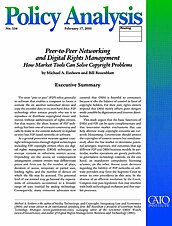As a general preventive measure against copyright infringements through digital technologies including P2P, copyright owners often use digital rights management (DRM) techniques to encrypt content or otherwise restrict access. Depending on the access or compensation arrangement, content owners may differentiate prices and limit use by the number of plays, duration of access, temporary or partial uses, lending rights, and the number of devices on which the file may be accessed. The potential level of use control may go beyond the expectations of consumers accustomed to a broader range of uses enabled by analog technology. Consequently, many consumer advocates now contend that DRM is harmful to consumers because it tilts the balance of control in favor of copyright holders. For their part, rights owners respond that DRM merely offsets grave dangers made possible by digitization and Internet distribution.
This study argues that the basic functions of DRM and P2P can be quite complementary and that innovative market mechanisms that canhelp alleviate many copyright concerns are currently blossoming. Government should protect the copyrights of content owners but simultaneously allow the free market to determine potential synergies, responses, and outcomes that tap different P2P and DRM business models. In particular, market operations are greatly preferable to government technology controls, on the one hand, or mandatory compulsory licensing schemes, on the other. Recent court decisions regarding the liability of P2P networks or software providers may force the Supreme Court to revisit its own precedents in this area. In the absence of an efficient resolution by the Court,Congress may pass legislation that may interfere with both technological evolution and free-market processes.

